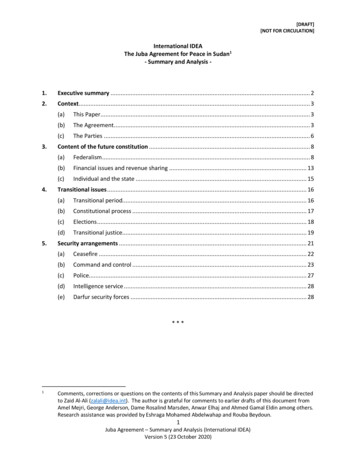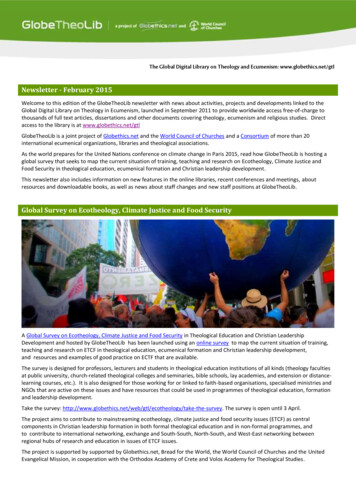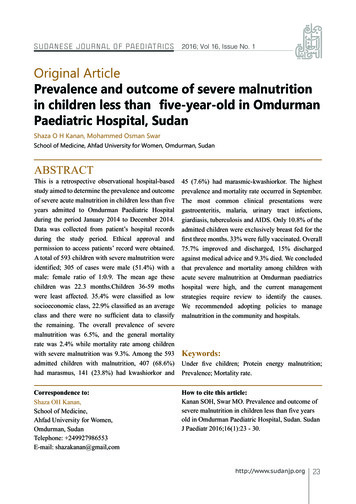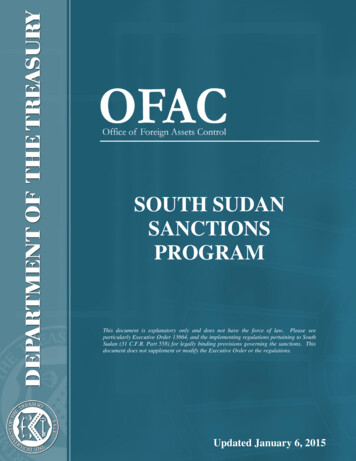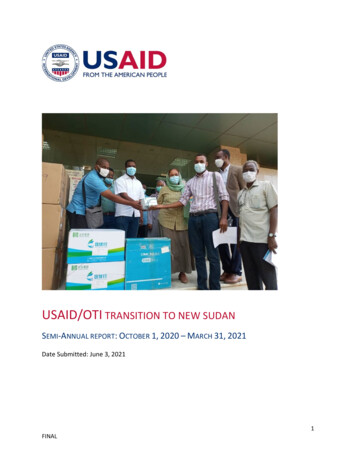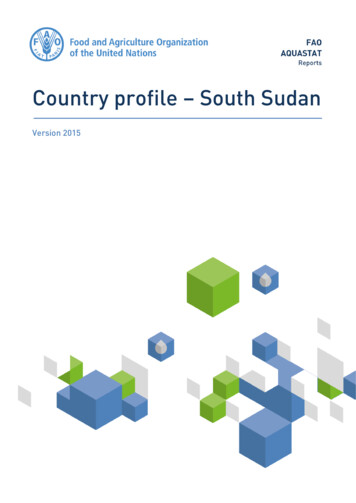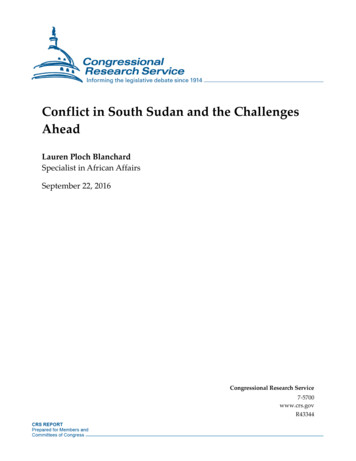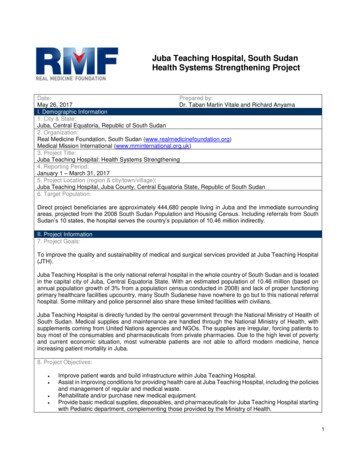
Transcription
Juba Teaching Hospital, South SudanHealth Systems Strengthening ProjectDate:Prepared by:May 26, 2017Dr. Taban Martin Vitale and Richard AnyamaI. Demographic Information1. City & State:Juba, Central Equatoria, Republic of South Sudan2. Organization:Real Medicine Foundation, South Sudan (www.realmedicinefoundation.org)Medical Mission International (www.mminternational.org.uk)3. Project Title:Juba Teaching Hospital: Health Systems Strengthening4. Reporting Period:January 1 – March 31, 20175. Project Location (region & city/town/village):Juba Teaching Hospital, Juba County, Central Equatoria State, Republic of South Sudan6. Target Population:Direct project beneficiaries are approximately 444,680 people living in Juba and the immediate surroundingareas, projected from the 2008 South Sudan Population and Housing Census. Including referrals from SouthSudan’s 10 states, the hospital serves the country’s population of 10.46 million indirectly.II. Project Information7. Project Goals:To improve the quality and sustainability of medical and surgical services provided at Juba Teaching Hospital(JTH).Juba Teaching Hospital is the only national referral hospital in the whole country of South Sudan and is locatedin the capital city of Juba, Central Equatoria State. With an estimated population of 10.46 million (based onannual population growth of 3% from a population census conducted in 2008) and lack of proper functioningprimary healthcare facilities upcountry, many South Sudanese have nowhere to go but to this national referralhospital. Some military and police personnel also share these limited facilities with civilians.Juba Teaching Hospital is directly funded by the central government through the National Ministry of Health ofSouth Sudan. Medical supplies and maintenance are handled through the National Ministry of Health, withsupplements coming from United Nations agencies and NGOs. The supplies are irregular, forcing patients tobuy most of the consumables and pharmaceuticals from private pharmacies. Due to the high level of povertyand current economic situation, most vulnerable patients are not able to afford modern medicine, henceincreasing patient mortality in Juba.8. Project Objectives: Improve patient wards and build infrastructure within Juba Teaching Hospital.Assist in improving conditions for providing health care at Juba Teaching Hospital, including the policiesand management of regular and medical waste.Rehabilitate and/or purchase new medical equipment.Provide basic medical supplies, disposables, and pharmaceuticals for Juba Teaching Hospital startingwith Pediatric department, complementing those provided by the Ministry of Health.1
Organize on-site clinical training, including general equipment usage, respectful maternity care andrespectful health care, and psycho-trauma support.9. Summary of RMF/MMI-sponsored activities carried out during the reporting period under each projectobjective (note any changes from original plans): Supplied pharmaceuticals with the donation from Direct Relief International.Refurbished the broken septic tank for Juba Teaching Hospital.Repaired and fixed leaking sink/tap in the Maternity ward.Improved RMF’s Juba storage facility.Supported the hospital’s human resource capacity by providing one RMF registered nurse, now servingin the Gynecology department.Continued to support RMF cleaners attached to the Surgical Emergency unit to supplement the fewcleaners maintained by the Ministry of Health (MOH).Procured and provided adequate cleaning materials for the Surgical Emergency unit to keep the wardsclean.Planned to continue supporting the high-speed Wi-Fi internet service at RMF’s office and the Maternityward.Continued monitoring and mentorship of trained healthcare professionals on the usage of HealtheVillages tablets.Facilitated and coordinated meetings with the MOH, UN agencies, and partners on how to improveservices at Juba Teaching Hospital (JTH).Conducted needs assessments in the Obstetrics and Gynecology wards for RMF support.10. Results and/or accomplishments achieved during this reporting period:RMF’s Health Systems Strengthening Project, focused on Juba Teaching Hospital (JTH), has achieved thefollowing milestones during this reporting quarter through our committed partnership with the National Ministryof Health, JTH administration, and JTH staff. The supply of pharmaceuticals for Juba Teaching Hospital (thanks to DRI’s support) has supplementedgaps, improving patient care and lifting the burden from patients who had to purchase some prescribedtreatments from private clinics.Maintenance work on the Maternity ward sink/tap has reduced the risk of infection and wasted water.The renovation work on the broken hospital septic tank has reduced WASH-related infections and iseliminating a public health hazard.The improved RMF storage facility now provides a safe space for storing nutrition and health supplies.The ANC continued to enroll women in the program with the help of antenatal cards provided by RMFduring the third quarter of 2016.The Antenatal Care Unit (ACU), improved/upgraded, well-furnished, and well-maintained by RMF,continued to provide quality antenatal care services for women and their families. The ACU alsoprovides a favorable learning environment for students from JCONAM, Juba Health Science TrainingInstitute, Juba School of Nursing, Central Equatoria School of Nursing/Midwifery, the Juba UniversityCollege of Medicine, and visiting teams.RMF supported one registered nurse, posted in the Gynecology department by Juba TeachingHospital’s management, to bridge the staffing gap in the unit and share her expertise.We continued to support high-speed Wi-Fi internet service at both the Maternity ward and RMF’s Jubaoffice, providing internet access to doctors and nurses (up to February) and RMF’s team (to date).The two Health eVillages (HeV) master trainers, along with Juba Teaching Hospital’s nurses, midwives,and doctors, continued to benefit from the HeV tablets. JTH staff is now able to do quick referencechecks, hence improving the quality of care and general services they provide.Monthly provision of adequate cleaning materials to the Surgical Emergency unit and support of 3cleaners ensured proper cleaning and maintenance of hygiene in the wards and the surroundingsWe facilitated and performed regular monitoring and supportive supervision of JTH healthcare workersand janitors on implementation of waste management policy guidelines.2
RMF continued to work closely with JTH administration and public health officers to ensure properimplementation of waste management policy guidelines and regular waste removal.11. Impact this project has on the community (who is benefiting and how): This project offers employment opportunities for South Sudanese nationals in both technical andsupporting positions.The Antenatal Care Unit (ACU, upgraded/improved by RMF, continued to provide comprehensiveservices for women and their families in a clean, well-organized environment.Waiting times in the Antenatal Care Unit (ACU) have been reduced, since there are now three wellfurnished examination rooms compared to only one before the renovation. This has a very positiveeffect, as women are receiving quality services and encouraging their communities to visit JTH, henceimproving the rate of institutional deliveries and overall pregnancy outcomes.Privacy: the remodeled Antenatal Care Unit (ACU) has three furnished examination rooms, whichensures privacy and encourages women to share their concerns and pregnancy related complicationswith healthcare providers. This plays a significant role in the overall outcomes of their pregnancies.There is now an adequate waiting area for conducting health education, which is positively influencingthe health habits of women and thus pregnancy outcomes; it is also encouraging child spacing andfamily planning services.There is now space for pre- and post-test counseling of pregnant women and their partners during theirantenatal visits.Students from JCONAM, Juba Health Science Training Institute, Juba School of Nursing, CentralEquatoria School of Nursing/Midwifery, the Juba University College of Medicine, and visiting teamscontinued to have adequate learning space and are interacting well with the pregnant women, tutors,and ANC midwives.The Gynecology department continued to benefit from the services of an RMF-supported registerednurse, who is filling a human resources gap for the hospital.The Surgical Emergency unit is kept clean, reducing nosocomial infections, and the premises areconducive to the health and well-being of healthcare providers, patients, and visitors.JTH premises and the surrounding areas are preserved and kept clean and safe through regularremoval of the waste which had posed a threat to the healthcare workers, patients, surroundingcommunity, and the environment.The working conditions of JTH’s janitorial workers have been improved through implementation of thewaste management policy, developed with the support of RMF staff.The high-speed Wi-Fi internet service at the Maternity department and RMF office provides internetaccess to doctors, nurses, midwives, and RMF’s team, facilitating research and improving continuousmedical education for healthcare professionals and coordination for RMF’s team.The healthcare professionals provided with Health eVillages (HeV) tablets continued to provideevidence based healthcare services for patients by using the devices as a guide.The trained healthcare professionals at JTH continued to practice the concepts of psycho-traumasupport, enabling them to identify and manage traumatized patients.12. Number served/number of direct project beneficiaries: Direct project beneficiaries are approximately 444,680 people living in Juba and the immediatesurrounding areas, projected from the 2008 Sudan Population and Housing Census.Students from JCONAM, Juba Nursing School, Juba Health Science Training Institute, the CentralEquatoria School of Nursing/Midwifery, and the Juba University College of Medicine are also directbeneficiaries of this project since they all do their clinical practice in Juba Teaching Hospital.13. Number of indirect project beneficiaries (geographic coverage):1. 10.46 million South Sudanese from all ten states, as per the 2008 Sudan Population and HousingCensus. Juba Teaching Hospital is the only national referral hospital for the entire country.2. All business communities from neighboring and other African countries, the working class fromNGO/INGOs, and UN agencies, etc.3
14. If applicable, please list the medical services provided:N/A15. Please list the most common health problems treated through this project. MalariaDiarrheal DiseasesIntestinal WormsRespiratory Tract InfectionsUrinary Tract InfectionsSkin InfectionsMeaslesMalnutritionEnteric FeverBurnsTrauma (i.e. Traffic Accidents)Gunshot Wounds16. Notable project challenges and obstacles.The project has made notable progress during this reporting quarter, but has faced challenges in the followingareas:1. As per Ministry of Health orders, the two blocks of the Accident and Emergency (A&E) department inJuba Teaching Hospital (JTH) are still not occupied following their successful upgrade/improvementby RMF. Patients are still lying on the floor due to lack of space. The A&E blocks are not serving thepurposes stipulated in the improvement proposal and agreed upon by the Ministry of Health in writing,thus hindering patients’ wellbeing.2. The operating theatres in the A&E department are not functional due to lack of equipment. This hindersthe performance of minor surgeries, since the main operating theatre is always fully booked.3. Power instability at Juba Teaching Hospital hinders effective and efficient service delivery, especiallyat night. The lack of reliable electricity has contributed significantly to the maternal and under-5mortality rates in Juba Teaching Hospital (JTH).4. Frequent interruption of running water in the hospital compromises cleaning and effective infectioncontrol measures, as well as normal functioning of the operating theatres and labor suite.5. Irregular and inadequate supplies of pharmaceuticals, consumables, and laboratory reagents forcespatients to buy most of the needed supplies from private pharmacies. Due to poverty and risinginflation, most people are not able to afford modern medicine, which increases patient mortality at JubaTeaching Hospital (JTH).6. Delay in staff remunerations by the MOH negatively affects the quality of service delivery at JTH.7. Many healthcare professionals are leaving the hospital for other employment.17. If applicable, plans for next reporting period:Continue to implement RMF’s annual work plan, guided by our MOU with the Ministry of Health (MOH).Follow up with support for the Obstetrics and Gynecology wards based on the needs assessment. Finalize and publish the Maternal Near-Miss Audit report. Continue to monitor the impact of the Health eVillages devices. Continue to organize on-site clinical training. Continue trainings on Respectful Health Care and Respectful Maternity Care, and continue to monitorand evaluate the impact of RMF’s Respectful Maternity Care Project through continued supervisionguided by RMF’s RMC supervisory checklist, specifically developed for this purpose. Continue to lobby for more financial resources to support the hospital.18. If applicable, summary of RMF/MMI-sponsored medical supply distribution and use: N/A4
19. Success story(s) highlighting project impact:See Project PhotosIII. Financial Information20. Detailed summary of expenditures within each budget category as presented in your funded proposal (fileattachment is fine). Please note any changes from plans.Provided separatelyProject PhotosThe clean, well-maintained ANC waiting area, a unit renovatedby RMFRMF logistic coordinator handing over a digital scale to theANC unitA midwifery student using the digital scale donated by RMF tomeasure the weight of a woman during an ANC visitA midwifery student using the digital scale donated by RMF tomeasure the weight of a woman during an ANC visit5
Clients waiting for PMTCT services in the ANC, a unitrenovated by RMFA woman (2nd from right) receiving her HIV test results duringan ANC visitA client undergoing a counselling session in the family A midwifery student performing abdominal palpation during aplanning unit of the ANCroutine ANC visitA midwifery student performing a general examination duringa routine ANC visitA mother receiving a blood transfusion following postpartumhemorrhage6
A midwifery student showing a young mother the best positionfor breastfeeding her newbornA student measuring the blood pressure of a pregnant womanduring an ANC visitAn old delivery bed in the labor suite at JTHEssential medicines donated by Direct Relief InternationalRepair of the JTH main septic tank in progressThe well repaired JTH septic tank7
Institute, Juba School of Nursing, Central Equatoria School of Nursing/Midwifery, the Juba University College of Medicine, and visiting teams. RMF supported one registered nurse, posted in the Gynecology department by Juba Teaching Hospital's management, to bridge the staffing gap in the unit and share her expertise.

